VoIP phone systems offer tons of advantages, especially for business use. Cost savings, scalability, usability, and an overall boost in efficiency are among the top noteworthy highlights.
With that said, VoIP (voice over internet protocol) solutions are reliant on a stable connection.
If your connection is unreliable, it’s going to impact the quality of your calls directly, causing echoing, static, or even dropped calls. As a business, you can’t afford to have these types of problems with your business phone system.
The solution? Running a VoIP speed test.
What is a VoIP Speed Test?
A VoIP speed test examines your internet connection’s integrity by measuring its performance across several key categories.
VoIP speed tests ensure that your existing internet connection can support a VoIP service and provide insight into the type of experience callers will have using a VoIP phone system.
Every business currently using or thinking about using a VoIP phone solution should run a speed test. These tests will help establish whether your existing internet connection can accommodate your call traffic and ultimately assess the overall health of your network.
5 Tools to Improve VoIP Speed Tests
Making sure you have a good VoIP provider is crucial, so check out our list of the best VoIP phone systems for your business. Then it is about testing the speed. Below we’ll highlight my favorite tools for running a VoIP speed test.
Tool #1 — Nextiva VoIP Speed Test
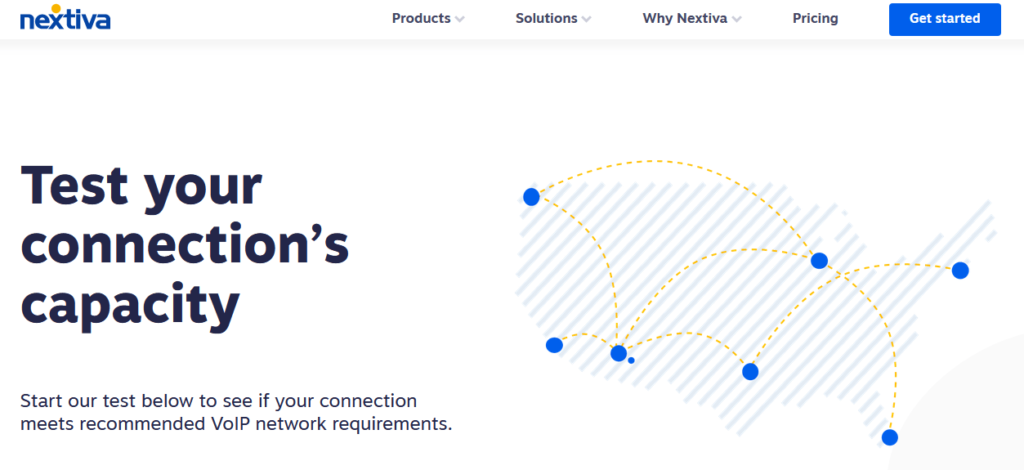
Nextiva is one of the best overall business phone solutions on the market today. It’s trusted by 100,000+ organizations worldwide. It’s more than just a phone system—Nextiva is an all-in-one solution for voice, video, messaging, conference calling, and team collaboration.
Nextiva offers a VoIP testing resource directly on its website. You can use it to determine if your internet connection meets Nextiva’s recommended network requirements for VoIP calls.
The test will also help you establish the number of simultaneous calls that your connection will support. Just select the starting point for your calls, and simulate a test with anywhere from two to 200 VoIP lines. This test also has advanced options for users who want more refined results. Click here to run a Nextiva VoIP speed test.
Tool #2 — RingCentral
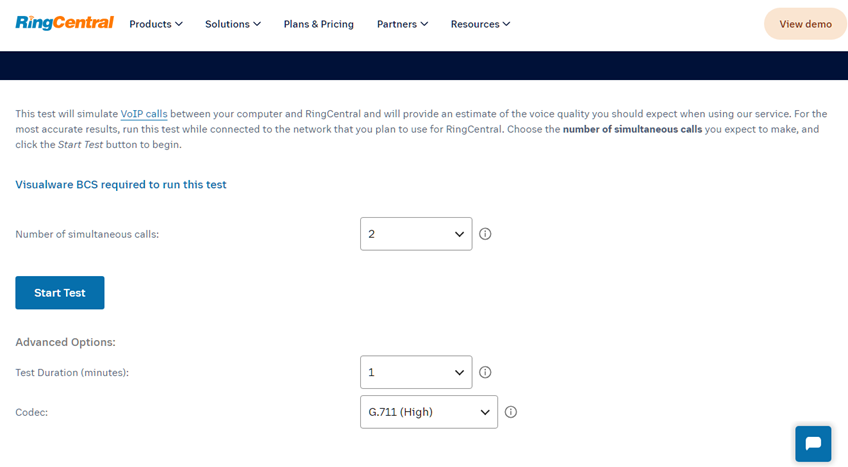
RingCentral is another industry leader in the business phone service space. We like RingCentral because they have solutions for everyone. Whether you’re running a small business or need a multi-site contact center solution for your global enterprise, this provider has it all.
For teams of 10 to 10,000, RingCentral is an all-in-one solution for business voice, integrated messaging, and video conferencing. It’s easy to deploy, and the scalability is limitless.
Use RingCentral’s quality of service test to simulate VoIP calls from your device and internet connection. The test will ultimately give you an estimated voice quality score. You can also figure out how many calls your internet connection can support.
RingCentral will also assign new customers an implementation advisor for multi-line phone systems. This helps ensure that your network and infrastructure are ready to support your new business phone system.
Tool #3 — 8×8 VoIP Speed Test
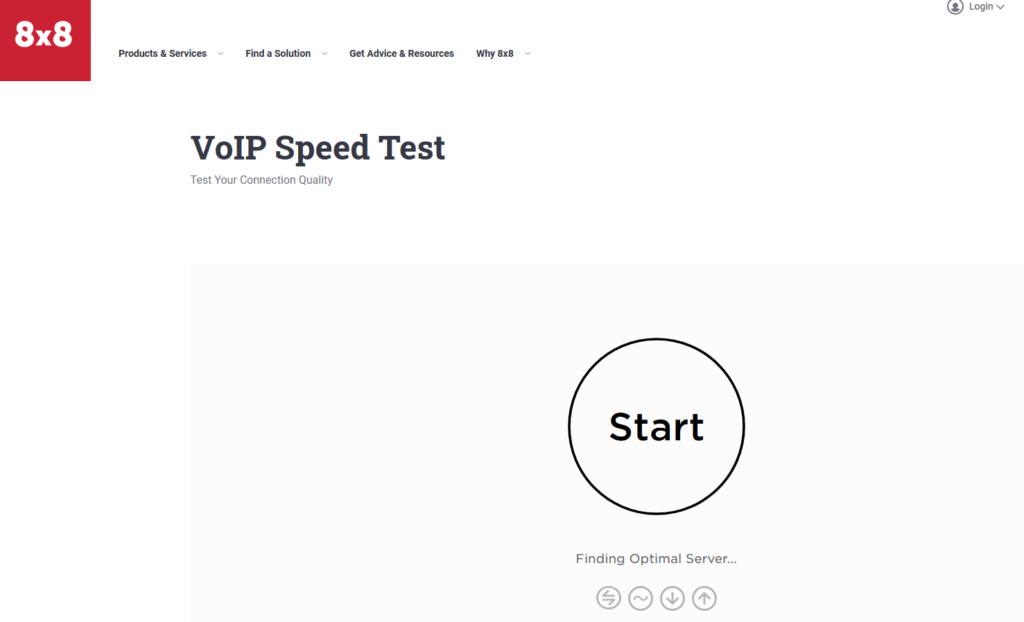
8×8 has solutions for cloud-based business voice, video conferencing, messaging, and contact centers. Over three million business users across the globe rely on 8×8 for VoIP communication.
It’s trusted by big names like Farmers Insurance, McDonald’s, and RE/MAX. 8×8 is best known for its industry-leading security compliance, reliability, and limitless scalability.
You can also use 8×8 to run a speed test directly from this link on their website. Just click the big “Start” button, and you should see the results in less than one minute. The test accounts for your download speed, upload speed, latency, and jitter. This test isn’t quite as advanced as some of the other tools on our list.
You’ll need to know how to read those results to make sense of everything. But if you need some assistance or have any questions, you can always reach out to a VoIP expert on the 8×8 sales or support team.
Tool #4 — Ooma VoIP Speed Test
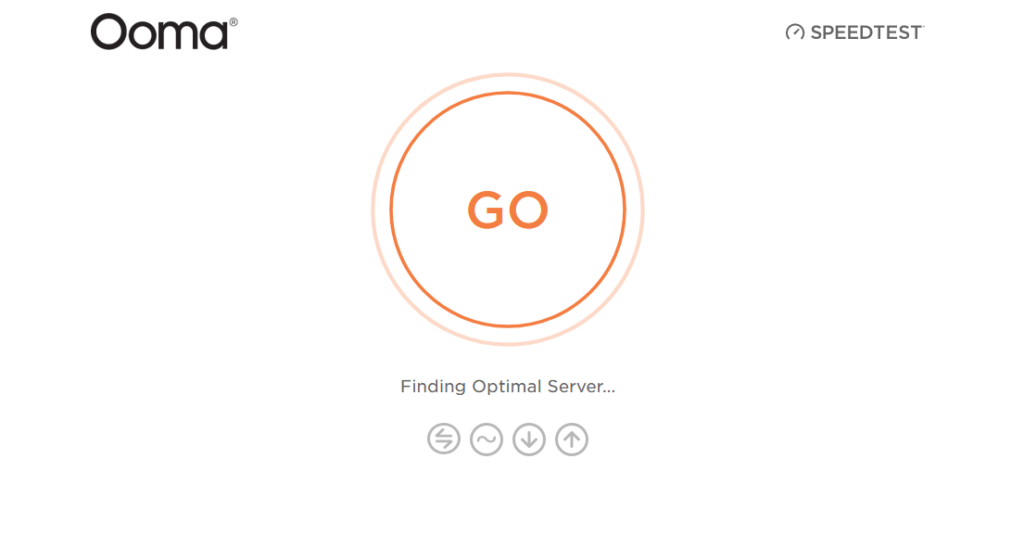
Ooma is another popular and reliable solution for business and residential internet phone services alike.
This VoIP phone system is affordable and easy to deploy. Ooma comes loaded with essential business tools like virtual fax, call forwarding, extension dialing, a call log, a virtual receptionist, and so much more. You can even use Ooma for things like video conferencing and call recording.
Use the Ooma Office Internet Speed Test tool to check your connection in seconds. The test measures download speed, upload speed, jitter, and ping. Ooma recommends that you need to have at least 256 kbps upstream and downstream for each simultaneous call. For example, if you think two people will be using the phone simultaneously, you’d need 512 of bandwidth upstream and downstream.
Tool #5 — OnSIP VoIP Test
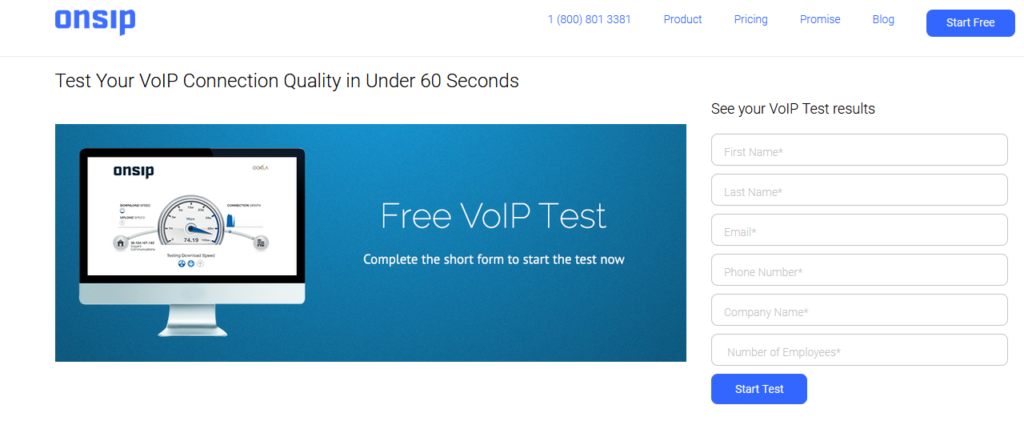
OnSIP is a hosted PBX phone solution. It’s designed to help organizations shift to remote work by replacing traditional business phone systems.
Keep your existing business phone number, and you’ll even get the benefits of a traditional business phone, including ring groups, conference bridges, and attendant menus.
Use the OnSIP VoIP Test to check your VoIP connection quality in less than one minute. The test will display upload speed, download speed, latency, and jitter through ping time fluctuations. Unlike some of the other VoIP test tools on the market today, it’s nice to see that OnSIP provides a full explanation of each scoring metric directly on its website. So even beginners can understand the results.
To complete the OnSIP VoIP speed test, you’ll need to fill out a short form with information about yourself and your business. It’s an extra step, but overall this is still a great option to consider.
The Basics of a VoIP Speed Test
Now that you know where to run your VoIP speed tests, it’s time to take a closer look at the basics. We’ve identified and explained the core components of a VoIP speed test below.
Internet Connection and Network
To run a VoIP speed test and deploy a VoIP phone system, you need to have an existing internet connection. This is not something that you’ll get from a VoIP provider. All of that is handled by a third-party internet service.
The vast majority of businesses in today’s day and age already have the internet set up. But depending on your speed test results, you might need to upgrade your plan or consider using another provider.
Your network plays an important role here as well. Networks can be defined as a group of devices connected to each other, communicating and sharing resources. You must consider the number of computers, users, and potential simultaneous VoIP calls.
Upload Speed and Download Speed
To ensure quality VoIP calls, you need to have enough bandwidth on your network to support call traffic. Things like your internet service provider’s network, your connection, LAN, and other factors will impact your upload and download speeds. One of the first steps to running a VoIP speed is checking to see if your speeds support the recommended kbps (kilobits per second) from the VoIP phone service you’re considering.
These recommendations vary from provider to provider. This can range anywhere from 100 kbps to 300 kbps, depending on the service. How many simultaneous calls will you need to accommodate at once? Again, this varies by business. But generally speaking, assume that at least 10% to 20% of users on your network will be on the phone at any given time.
Latency
In VoIP terms, latency (also known as ping or delay) refers to the time it takes for the speaker’s voice to reach the ear of the receiver. The lower the latency, the better. Generally speaking, we want latency to be under 150ms.
Once your latency goes above the 150ms mark, it can become a problem. There will be a noticeable delay between the callers, which ultimately impacts the quality of the call. To be clear, latency doesn’t really affect the sound quality, but it will impact all parties’ experience on the line. If you’ve ever been on a call with these types of delays, it can be really frustrating to have a conversation.
Jitter
For voice communication to travel over an internet protocol, it must be converted into digital information. All of this info is broken up into packets to ease transmission. Jitter is the variation between these data packets, which is caused by route changes or network congestion. The longer it takes to transmit data packets, the more jitter will be experienced.
In layman’s terms, jitter impacts call quality. Dropped calls, choppy audio, static, inaudible sound, and delays are common signs of jitter. Obviously, you want to avoid this at all costs.
Jitter should always be lower than 25ms, but high-quality calls will have a jitter rating below 15-20ms.
3 Tricks For VoIP Speed Tests
After running dozens of VoIP speed tests throughout our careers, we’ve identified a few quick tips and hacks for making this as easy as possible. Check them out below, and you can apply these VoIP speed test hacks immediately.
Trick #1: Make Sure You Have a Good VoIP Provider
Your internet connection is only half of the battle. Even if you have excellent speeds, low latency, and no jitter on a speed test, that won’t automatically translate to a great experience with just any VoIP phone service. With dozens of potential VoIP phone providers to consider, these services are definitely not equal across the board.
If you’re using a VoIP phone service for the occasional personal call, this won’t be a huge deal. But for business use, finding the right VoIP provider is crucial. Check out our list of the best VoIP phone systems for your business. In addition to our reviews and recommendations, we also explain exactly how to choose the best VoIP phone service for your business.
For those who want a quick answer and don’t feel like reading that guide, Nextiva and RingCentral are our top recommendations.
Trick #2: Run the Test with an Idle Internet Connection
Many VoIP speed tests will say this before you start, but that’s not the case for all of them. To get the best possible results for your VoIP speed test, make sure your connection is idle. In short, don’t have other users or applications running in the background.
In a traditional office setting, this can be tough. It’s not always realistic to tell everyone on your network to stop what they’re doing and close all applications using the internet. So you might have to run the test after hours or at a time when there’s less internet activity.
If you’re running the test at home for remote work, make sure your family isn’t streaming movies or FaceTiming with friends while you’re conducting the test. This type of activity will impact your results.
Trick #3: Don’t Pay For VoIP Speed Tests
There’s no reason to pay a fee for a speed test. Some tools out there charge for this service, but you can get a free VoIP speed test from every solution listed earlier in this guide.
Paid VoIP speed tests are a ripoff and not necessary. If you’re doing a more advanced VoIP quality test and want ongoing monitoring once you’re up and running, that’s another story altogether. But for an initial quick test, stick with a free option.
